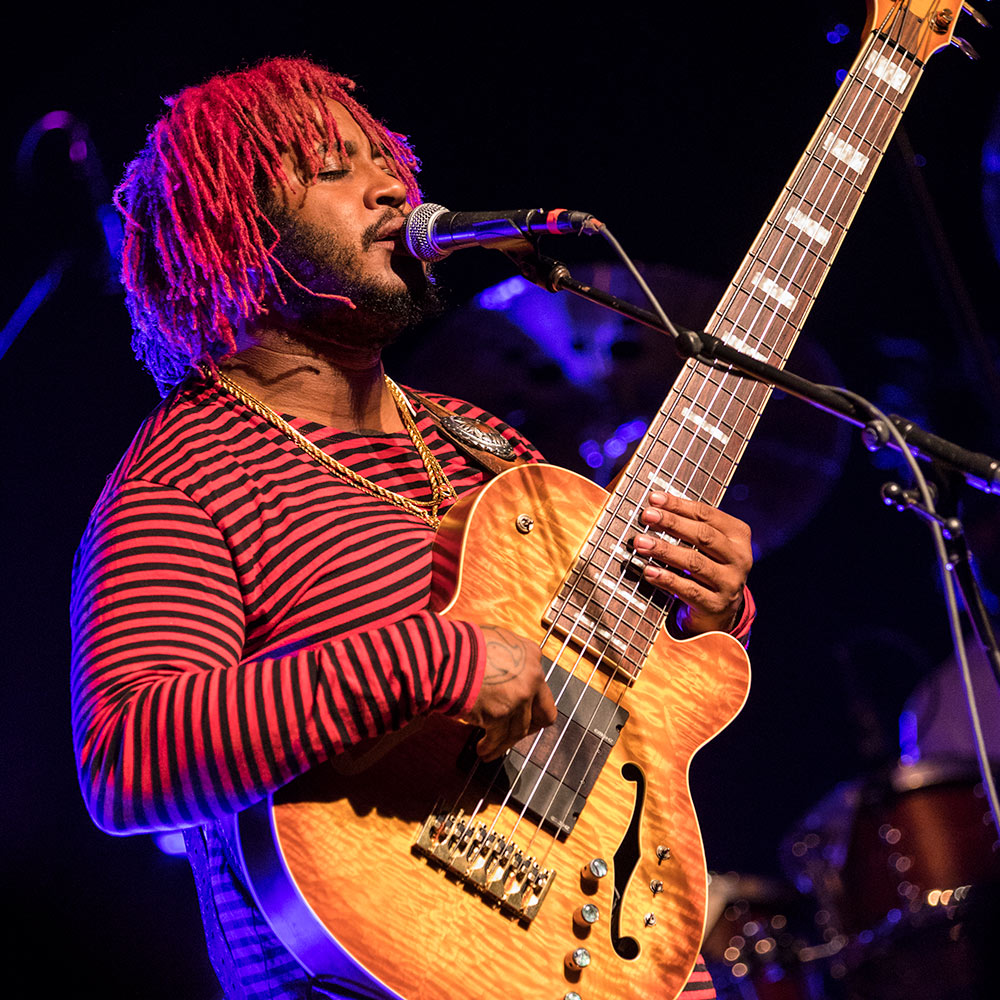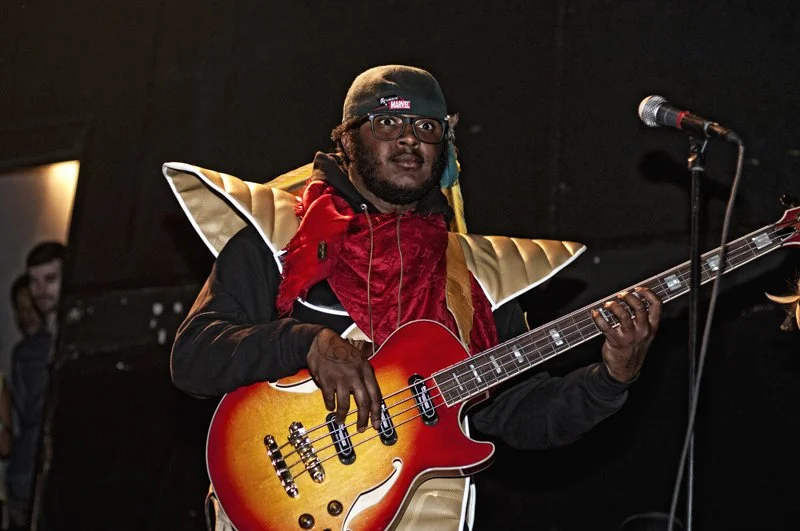Get familiar with iconic bass player Thundercat's gear of choice.
The fact that Thundercat isn’t an outright household name is almost criminal. Born Stephen Bruner, the eccentric bass virtuoso’s resume is mind boggling to look at – ranging from thrash-punk titans Suicidal Tendencies to neo-soul royalty Erykah Badu, through to New Zealand crooner Kimbra and Brainfeeder label-mate and electro-jazz collaborator Flying Lotus, Thundercat has done it all, and a Thundercat bass performance is really something to witness.
Read all the latest features, columns and more here.
However, his defining moment for many came in 2015 with the release of Kendrick Lamar’s magnum opus To Pimp A Butterfly, with Lamar describing Thundercat as being at the creative epicentre of the record, writing and playing on everything from “King Kunta” to the Grammy award winning “These Walls”
Thundercat bass
Whether it’s his squiggly jazz bass fills or soothing falsetto vocal harmonies, Thundercat’s presence on a track is immediately recognisable and instantly fulfilling, and with the release of his collaboration with Tame Impala’s Kevin Parker “No More Lies”, he is finally starting to achieve the acclaim as a solo artist that he’s demanded so much throughout his extensive career as a session musician.
In celebration of the bottom-end brainiac, we look at the gear that helps Thundercat make unconventional noise beautiful.
Custom Ibanez Six String Artcore

Thundercat has a penchant for the weird and wonderful, and nothing allows him to exemplify this more than his own signature bass. A 2012 Custom Shop model made in Ibanez’s LA factory, this machine is heavily modified to suit Thundercat’s genre spanning playing style, boasting six strings (tuned BEADGC), a hollowed-out maple body with a five-piece maple/jatoba neck and a rosewood fingerboard.
For electronics, Thundercat favours a custom Graph Tech Ghost Modular MIDI pickup system in conjunction with two custom EMG-HZ pickups, with a myriad of knobs and switches to control master volume, tone, piezo and MIDI volume, volume for the MIDI system, a 3-way pickup switch, and a dark/mids control.
MTD Custom Shop Six String Bass
Prior to attaining his custom Artcore in 2012, Thundercat laid the funk down on a custom shop MTD six string model, featuring a full maple body and neck with custom EMG electronics, which you can hear in the solo of his collaboration with Flying Lotus ‘MmmHmm’.
Custom Ibanez Four String Artcore

Similar in design to his six string model, Thundercat also owns a four string thin-line variant of the Ibanez Artcore AGB200 hollow body bass. Featuring three single coil pickups controlled with a three-way switching system and volume/tone knobs, this one is actually one of the most normal instruments in Thundercat’s arsenal, which definitely says a lot about the eccentric artist.
Thundercat also owned a five-string, solid body variation of this instrument, which you can spot him rocking throughout this video of Suicidal Tendencies’ thrash-punk anthem ‘Institutionalized’.
Custom Double-Neck Ibanez BTB
There’s really nothing quite like a double-neck instrument, but this one is almost too much to handle. Combining two five-piece maple/bubinga necks with maple fingerboards and a spalted-maple top, ash middle and crotch mahogany back body, Thundercat gushed about this bass in an interview with Bass Player Magazine. “It’s fantastic. It’s got this Pink Floyd-ish tone that’s really open,” he said. “It rings out because there’s the 6-string on top and an 8-string on the bottom, both with EMGs. I wanted to go for that vintage P-Bass sound, but there’s hardly any lacquer on the wood, and it’s like this open ‘baaaaang!’ It’s pretty funky; it has its own life.”
Specs-wise, this monster features an Ibanez EQ with a 3-way toggle for the neck selector switch and two 3-way toggles for the pickups, with Aguilar 6P-60 P-Bass pickups on the six-string and Seymour Duncan NYC humbuckers on the eight string, complete with jumbo frets, Hipshot tuners, and Hipshot bridges to make this bad boy sing. Check out the above video of him chatting to Complex while noodling around on the instrument.
Amplifiers
Before rising to prominence as a both a session player and solo artist, Thundercat used a SWR750x head with two matching SWR 4×10 cabinets, refining the Thundercat bass sound.
These days, Thundercat is endorsed by New York based amplification masters Aguilar, and tends to switch between using Tone Hammer 500, DB 750, or DB 751 head depending on the situation, usually through either in conjunction with two Aguilar GS410 or DB410 cabinets.
Effects
While his irresistibly squelchy bass tone may suggest otherwise, Thundercat manages to squeeze his sound out of a surprisingly limited effects chain – however, the MIDI pickup in his Ibanez six-string may play a larger role in some of his tonal modulations. “Live, I’m using a DigiTech Whammy pedal with the octave up,” he said in an interview with Bass Player Magazine. “And a Pigtronix Bass Envelope Phaser. The Pigtronix is powerful—it reminds me of a Mu-Tron Bi-Phase, but it’s nice not to have to deal with the weight of a Bi-Phase. I’ve also played with a Moogerfooger MF-103 12-Step Phaser, and I used to have a Boss SYB-5 (Synth-Bass pedal).”
Previous iterations of Thundercat’s board have also included a Moog MF-104M Cluster Flux chorus/vibrato, a MF-104Z analogue delay, and a MF-101 low pass filter, which can be seen in the video below.
Strings
To achieve maximum chordal control and dexterity over the bass’s fingerboard, Thundercat uses a unique combination of both nylon wound and flat wound strings. Endorsed by La Bella, he switches between Deep Talkin’ Bass Flats (.029, .049, .069, .089, .109, .128) and 750G-CB Gold White Nylon Tapewounds (.043, .050, .065, .085, .105, .135 for live performances, and often uses medium-light Dean Markley SR2000 strings (.027, .047, .067, .087, .107, .127) for studio work.
Take a look at some of Thundercat’s favourite bass lines below.
For more, watch a Thundercat bass perform using his Custom Ibanez Six String Artcore in this Tiny Desk Performance.







